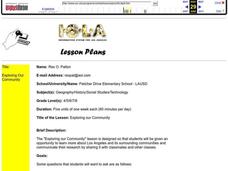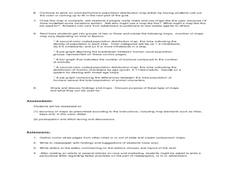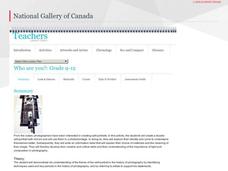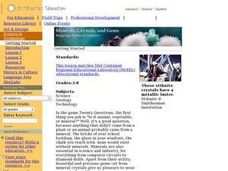Curated OER
Native Americans - People of the Plains
Students explore Plains Indians and practice computer skills by reading creation and migration stories on People of the Plains CD-ROM, and watching Plains video. Students examine village life of Plains Indians, and view different...
Curated OER
"Getting to Know You": Discovering the Role of MPs in Canada and the Netherlands
Students learn the role of Canada's MPs compared to that of the Netherlands using a partnered school program.
Curated OER
Sing a Song of Coinage
Students examine the Tennessee state quarter. They discuss Tennessee's musical heritage, examine all of the coins and as a group, create a song about coins or money. They also complete worksheets pertaining to the lesson.
Curated OER
Exploring our Community
Pupils research Los Angeles and its surrounding communities. They create digital presentations of the information they have gathered by answering the question included in the lesson.
Curated OER
Ancient Cultures
Students develop archeological skills in order to explain how scientists determine what ancient cultures were like. They develop an appreciation of the work that is involved in finding out about our past.
Curated OER
Schools Around the World
Students discover how schools around the world are the same and different. In this international school lesson, students learn about different types of schools from all around the world and the items and activities within these schools....
Curated OER
What and Where is Puerto Rico?
Students explore Puerto Rico. They create K-W-L charts of their prior knowledge of Puerto Rico and observe maps of Puerto Rico. They code the map for measurements and land and water forms. They explore websites to gain background on...
Curated OER
Mummy Tales
Students research types of mummification. In this burial customs lesson, students work in groups to research different types of mummies and present their research to the class. Students compare and contrast the types of mummification.
Curated OER
What is the Population Distribution of Cartoon Characters Living On the Pages of Your Newspaper?
Learners read various cartoons in their local newspaper and calculate the population demographics, spatial distribution and grouping of the characters. Using this information, they create a population distribution map and share them with...
Curated OER
How Can We Locate Specific Places On Earth?
Second graders discover how to use longitude and latitude to locate specific sites on Earth. They compare old and new ways of locating specific places, and discover how latitude and longitude coordinates are used to locate places on Earth.
Curated OER
Blooming Thermometers
Students study phenology, or the study of climate change. They research the Japanese springtime festival of Hanami and plot and interpret average cherry blossom bloom date data from the past 1100 years.
Curated OER
Treaty Trail: Crossing the Bitterroot Mountains
Learners examine art and primary documents that depicts the Native Americans' crossing of Washington's Bitterroot Mountains to arrive at the Spokane Council. Students investigate and compare maps and other historical materials determine...
Curated OER
In Search of the Amber Room
Students watch the film, "In Search of the Amber Room." In teams, they examine World War II and research to find the Amber Room. They present their case in written form, or as a Web site, or using video "clips" from the film
Curated OER
The Immigrant Experience
Students utilize oral histories to discover, analyze, and interpret immigration and migration in the history of the United States. A goal of the unit is fostering a discussion and encouraging students to make meaning of the bigger...
Curated OER
Continents and Oceans
Students identify oceans and continents and their locations on a map. They color-code and label their own map of the world's continents and oceans. They play the game Continents and Oceans to identify specific areas.
Curated OER
Who Are You?
Students complete self projects such as a collage, an acrostic poem, a mural, and more, to show their similarities and differences. For this similarities and differences lesson plan, students can do these projects individually or in groups.
Curated OER
French and Indian War
Seventh graders complete a unit on the French and Indian War. They conduct an Internet document search and use what they find to complete a document based essay about the war.
Curated OER
A Bird's Eye View of the Caribbean: Art, Folklore, and Music
Students examine the Caribbean in terms of its music, art, and folklore. As a class, they listen to a folktale and discuss the difference between telling a story and reading a story. In groups, they write their own folktale and share...
Curated OER
Read a Transportation Story
Sixth graders read a story about intercontinental truck drivers and their journeys. In this transportation lesson, 6th graders read the novel Kamyonistan by Robert Hackford and discuss the travels of the truck driver through the Middle...
Curated OER
Minerals, Crystals, and Gems
Students discover the relationships between minerals, crystals and gems. They bring in rocks that they find at home, in the schoolyard, etc. and examine them and attempt to identify them. They set up a classroom exhibit that includes all...
Curated OER
Core Book Guide for The Upstairs Room by Johanna Reiss
Students read and discuss The Upstairs Room by Johanna Reiss.
Curated OER
Uncharted Territory
Students examine what were preconceived perceptions of the areas Lewis and Clark explored. They compare and contrast past and modern maps of North America. They accurately place route and site information on the map.
Curated OER
Is A Nation Always A Region?
Students define the term, "nation," and analyze the boundaries established in Africa by colonial powers. In small groups, they participate in a simulated United Nations, develop a list of questions, analyze the nations of Africa, and...
Curated OER
Teaching With the Power of Objects
Students define value of an object. In this value lesson plan, students identify reasons for collecting objects, compile a personal inventory of items they find valuable, and then define why those items are valuable to them. In step two...

























